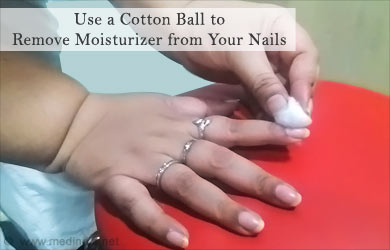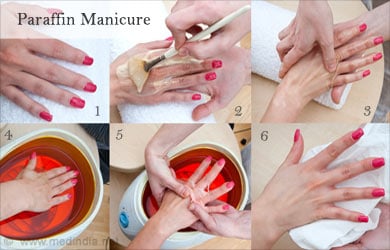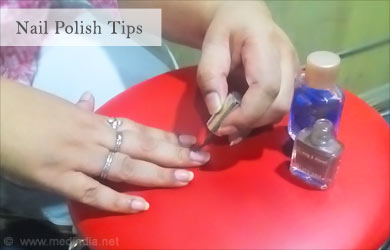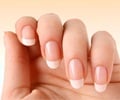How to do a Manicure at Home?
A regular manicure involves the cleaning and exfoliation of the hands and fingernails. The person’s hands are exfoliated and moisturized while their cuticles are pushed back or trimmed and the finger nails are filed into the desired shape. Although salons and spas offer this treatment, it is easy to do your own manicure at home.
Follow the Following Steps for a Perfect Manicure at Home:
- Remove all traces of chipped or old nail polish from your nails using a cotton ball dipped in nail polish remover. Minimize the contact duration of the nail polish remover with your nails and skin as it has a drying effect. Once you are done, wash your fingernails under running water. If you want to get rid of the residual powder left by the remover, you can use an old toothbrush to clean your nails.
- Soak your hands in a bowl of warm water and if you like, you can add a few drops of an essential oil to the water. Jojoba oil, sweet almond oil and wheat germ oil are all excellent choices, as they will help to nourish and moisturize your skin.

- Use an emery board to shape your nails – you can choose from a variety of shapes including oval, square, pointed, almond or square oval (generally known as “squoval"). Avoid using a metal file to shape your nail as this can result in splintering. Use a slightly abrasive buffer over the tops of your nails as this will ensure an even but not unduly smooth surface. If the surface of your nails is very smooth, the nail polish will not adhere to the nail and will chip off more easily.
- Soak your hands once more but keep them immersed for no more than 5-7 minutes. It is important to soak your hands at this point, as it will make your cuticles softer so that you can trim them easily. You can use a timer to make sure that you don’t over-soak your hands as this could cause your nails and skin to dry out.
- Dry your nails well with a towel and then carefully trim the thickened skin around your nails. You can also use the edge of a pumice stone or a stiff-bristled brush to gently exfoliate your skin after you have trimmed the thickened skin at the corners of your nails. Gently push your cuticle back and nip it if necessary with cuticle trimmers. Be very careful when removing cuticles, hangnails or callouses as you could damage your skin and hurt yourself in the process. If you have thickened skin on your palms, massage them thoroughly with a pumice stone.
- Dip your hands in the warm water bowl for just a minute and then take them out and shake off the excess water. Apply a moisturizer liberally to your hands and work it into your skin to keep your hands smooth and moisturized. You can make your own moisturizer by mixing equal amounts of virgin coconut oil and aloe vera gel.
- Use a cotton ball soaked in warm water to remove the moisturizer from your nails. Repeat this step a couple of times to make sure that you get rid of all traces of the moisturizer as this will ensure that the nail polish adheres to your nails.

- Paint your nails with two coats of nail polish and allow the first coat to dry completely before applying the second coat.
Types of Manicures
There is more to a manicure than simply shaping and polishing your nails. There are different types of manicures that differ from each other in the treatment process, the type of nail polish used or even the design created using nail polish. Once you have learnt the basics of how to do a home manicure, you can experiment with various manicure types. Here are a few of the most popular types of manicures:
French Manicure
It is the most common type of manicure as its chic and polished look is suitable for just about any occasion. With a French manicure, the base coat is a pale pink or peach color. The tips of each fingernail are then painted with a white crescent strip. Once the polish has dried, a clear top coat of nail polish can be applied for a smooth and even finish. French manicure kits provide crescent-shaped nail guides to make sure that the white polish follows an even curve. If you do not have a nail guide you can make your own by cutting out a gentle curve in a strip of painter's tape using a sharp scissors.
Reverse French Manicure
It is just what the name suggests – the entire nail is painted a peach or pink color with tiny “moons” of white paint near the base of the nail. Some women prefer thin U-shaped bands of white near their nail bed instead of the regular moon shaped bands.
Paraffin Manicure
Paraffin manicures have gained popularity despite being quite expensive as they are excellent at softening and moisturizing skin. Paraffin wax is heated to about 35 °C before being applied generously to one’s hands. When trying this method at home, make sure that the wax is not too hot or you may injure yourself. Apply a cream or a little essential oil to your hands before immersing them in paraffin wax as the heat will promote the absorption of creams and moisturizers. Wrap your hands in plastic wrap to help trap the heat for about 30 minutes before peeling off the wax.

Hot Stone Manicure
It uses large flat pebbles that have been heated to encourage muscle relaxation and help you unwind. Generally, warm basalt stones are used and this type of manicure is an excellent choice for those who suffer from aches and pains in their knuckles and hands. The warm stones are also used to massage the palms, forearms and fingers to soothe the muscles and joints.
Gel Nail Polish Manicure
It is a rather recent entry into the market. Unlike regular nail polish that dries within a few minutes of contact with air, gel nail polishes do not dry automatically. Once the polish is applied on your nails, you will need to place your nails under a UV lamp so that the nail polish can cure and become dry. The plus side to using gel nail polish is that they generally last for two weeks while regular nail polish often chips in less than 5 days.
Manicure Tip and Tricks
- When it comes to a do-it-yourself manicure, the trick is to apply several thin coats of polish rather than one thick coat. If you apply a single thick coat, only the top of the layer will dry which will make it easier for it to smudge.
- Apply a little Vaseline or lotion to your cuticles with a cotton swab before you apply your nail polish. This is one of the best home manicure tips for those who find it hard to apply nail polish perfectly. Even if a little polish goes onto your skin, the vaseline will prevent it from adhering to your skin so you will be able to simply wipe it off later.
- The two important points to remember when it comes to polish is that regular nail polish takes more time to dry if the humidity level is high and when you are at home, gel manicure tips such as not exposing your nails to hot water will prevent cracking and peeling.

- Some men might feel awkward going to a salon to get a manicure and so they can just do it at home. A manicure for men focuses on getting rid of rough callouses and dead skin. A manicure for men is pretty similar to a manicure for women with the obvious exception of nail painting. If you have never given yourself a manicure before, you can start by soaking your hands and then giving your hands a light scrub with a pumice stone. Don’t bother with your cuticles, but instead concentrate on cutting your nails neatly before you file them lightly.








